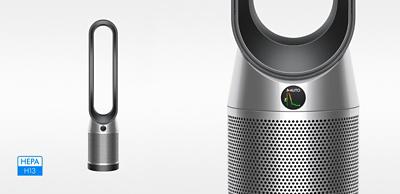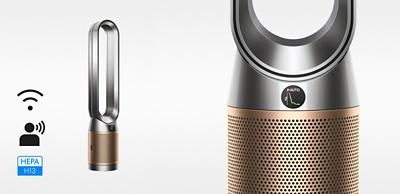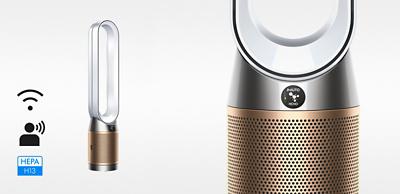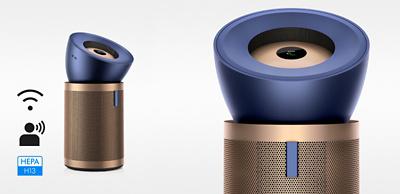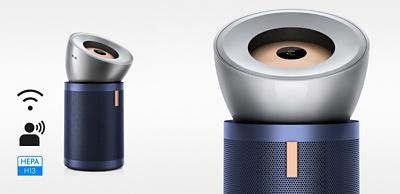
Fans and heaters
Powerful Dyson airflow to heat and cool you³
Discover Dyson purifying fan heaters this winter. Air Multiplier™ technology amplifies airflow to heat and cool you³ quickly and quietly. For a more comfortable home environment.
Price match promise
Price Match Promise
Be confident that you’re getting the best price on Dyson.com. If within 30 days of purchase you should find the same model currently advertised at a lower price by an authorized US Dyson retailer or by Dyson on a third party marketplace site, we'll refund you the difference if the below details are satisfied. Visit dyson.com/pricematch, the chatbox on Dyson.com, or contact our Customer Service team at 1-866-693-9766 to get started. Here are the details you need to know:
- Machine must be the exact same model number as it appears on Dyson.com and in stock. You can identify the machine serial number on the box or on the product itself. To locate the serial number on your product, please visit dyson.com/serial-number-help for location details by specific machine.
- Proof of advertised price by an authorized dealer is required (Valid copy of flyer or website URL required. Advertised price must be the listed price; membership/loyalty, promo code entries or like discounts are not eligible for price matching).
- If you have any questions about whether a seller is authorized, please contact the Dyson Helpline. Please note that our only authorized sellers on Amazon.com are "Amazon.com," "Allied Hand Dryers," and "Berl's Commercial Supply."
- Machine must be new and in original packaging. It cannot be used, damaged, returned, open box, "close out", "clearance" or a demonstrator machine.
- Machine price must not be lower due to an advertising error or misprint.
- Hair care machine and accessories, which include, but are not limited to, the Dyson Supersonic", Dyson Supersonic r', Dyson Supersonic Nural™, Dyson Airwrap i.d.™, Dyson Airwrap Co-anda2x™, Dyson Airwrap™, Dyson Corrale™, and Dyson Airstrait™ are not eligible for price matching.
- Lower price will not be honored if the result of a violation of a Dyson unilateral advertising or pricing policy or if doing so would result in a violation of a Dyson policy
Dyson reserves the right to rescind this offer at any time and/or modify these terms and conditions as needed.
Free shipping on all orders
Free shipping is applied to all orders (Arrives in 2-7 business days).
Orders containing a tool, spare part, accessory, or gift with purchase may ship separately (Arrives in 5-7 business days).
2-Year Limited Warranty
Dyson Limited Warranty Terms and Conditions
Dyson carefully monitors laws and regulations related to warranties and routinely updates its warranty terms and conditions. We endeavor to ensure that warranty terms included with products are updated as quickly as possible, but to ensure you are viewing the current warranty terms and conditions, please visit: The Dyson Limited Warranty Terms & Conditions.
30-day money-back guarantee
Money-back guarantee
If you’d like to return a Dyson machine for a full refund, you need to return the machine, accessories, and attachments within 30 days from the delivery date. For purchases made at a Dyson Demo Store or Dyson Service Center, a return must be made within 30 days from the purchase date. Dyson Direct will pay for return shipping.
Customer Service Helpline
If you have questions please contact us. You can email or call:
questions@dyson.com - Our Digital Support team is available 24 hours a day, 7 days a week. Most inquiries are handled within two hours or less
1-866-MY-DYSON (1-866-693-9766) - Our Helpline is available from Monday-Saturday (closed Sunday).
Extended Holiday returns
Purchases made between November 1st and December 25th can be returned up until 5:00 PM CST on January 31st, 2026. Dyson Direct will pay for return shipping.
If you wish to return any product purchased from Dyson Direct, please contact our toll-free Contact Center at 1-866-MY-DYSON (1-866-693-9766) or visit dyson.com/returns prior to returning your merchandise.
To receive a full refund for an item purchased from Dyson, please follow these three steps:
Call the Contact Center to initiate your return and to identify the correct return shipping address and method.
Package the item(s) to be returned in the original Dyson packaging.
Send your returned item(s) shipping prepaid to Dyson within 30 days of purchase for a full refund. Unauthorized or COD returns will not be accepted.
Please allow 4-8 weeks for return processing. Products returned to Dyson will receive a full refund and Dyson will pay for the return shipping.
Refurbished machines are considered final sale and are not eligible for returns, only warranty service.
Key features and technology
-
Powerful airflow to cool you³ quickly
Air Multiplier™ technology combines principles used in turbochargers and jet engines to amplify airflow. For fast, powerful cooling and long-range projection.¹
-
Sleep timer
Set your fan heater to turn off at preset intervals, from 15 minutes to 9 hours.
-
Bladeless and easy to clean
No fast-spinning blades. No visible heating elements. Easy to clean. Automatically shuts off if tipped over.
-
Diffused mode
This mode projects airflow over a wider angle, to heat the whole room quickly and evenly.¹⁷
-
Jet Focus mode
Focus mode channels a narrow jet of air for fast cooling. Air is accelerated through a small aperture, then redirected by a focus ramp to where you need it.
-
Ceramic plates for fast room heating
Positive temperature coefficient ceramic plates heat the air as it’s projected.
-
Cools or heats you


AM09
1 color available now starting at $349.99
- Air Multiplier™ technology amplifies airflow up to 15 times, to heat and cool you³ quickly and quietly.
- Jet Focus and Diffused modes for personal or whole-room heating¹⁷ and cooling.
- Smooth oscillation.
- Remote control with 10 airflow settings.
-
Cools you


AM07
2 colors available starting at $399.99
- Air Multiplier™ technology amplifies airflow up to 15 times, to cool you³ quickly and quietly.
- Bladeless fan for personal cooling.
- Smooth oscillation.
- Remote control with 10 airflow settings.
Purifies, heats or cools you
-


HP2
2 colors available now starting at $779.99
- Advanced air purification automatically captures 50% more NO₂. Even destroys formaldehyde.±
- Captures 99.97% of ultra-fine particles as small as 0.3 microns. Removes odors and gases.²
- Purifies and heats the whole room evenly.⁸ Cools you in summer.³
Cools and purifies
-


PC1
3 colors available now starting at $499.99
- Automatically senses, captures and traps pollutants. For you and your family to breathe cleaner air and live in a healthier environment.
- Cools you fast with smooth, powerful airflow.³
- Captures 99.97% of particles as small as 0.3 microns2 – to purify your whole room evenly.8
- Control and monitor air quality from anywhere using the MyDyson™ app.⁵


BP04
1 color available now starting at $1099.99
Projects air over 32ft and purifies large spaces.¹ Quietly.
- Captures 99.97% of fine particles as small as 0.1 microns. Destroys formaldehyde.⁺
- Control with MyDyson app⁵
- Automatically detects CO₂, airborne particles, gases and formaldehyde.
- Absorbs 3x more NO₂.⁴ Removes gases and odors.²
-


PC2
2 colors available now starting at $749.99
- Fully sealed, 3-stage HEPA H13 grade filtration captures 99.97% of particles as small as 0.3 microns.²
- Removes odors and gases², and continuously destroys formaldehyde.⁺
- Control and monitor air quality from anywhere using the MyDyson™ app, or hands-free with compatible voice services.⁵
- Set schedules and receive personalized air quality reports via the MyDyson™ app.⁵
-
Allergens
An allergen is a substance that can cause an allergic reaction by triggering the body’s immune system. Common indoor allergens include pet dander and pollen.¹⁰
-
Bacteria
Microscopic, single-celled organisms that can exist in their millions, in every environment. Not all bacteria are harmful, but some can have adverse effects, such as E. coli.¹⁰
-
Benzene
Benzene is colorless, flammable liquid produced by both natural and man-made processes. It’s a natural part of crude oil, gasoline, and cigarette smoke. Indoors, it comes from products such as glues, paints, furniture wax, and detergents.
-
Carbon dioxide (CO₂)
A colorless greenhouse gas, which comes from the extraction and burning of fossil fuels. Increased CO₂ levels can impact cognitive function.
-
Formaldehyde
This colorless, flammable gas is used in some building materials and household products. Sources can include some fabrics found in flooring and furniture, glues, paints, varnishes, air fresheners, and household cleaners.
-
HEPA 13
HEPA (High Efficiency Particulate Air) is an air filter efficiency standard and a measure of a filter’s performance. To achieve this standard, filters must meet a minimum of 99.95 per cent particle removal at the most penetrating particle size.
-
Humidification
A process of increasing air moisture content through the addition of water vapor or steam. Humidifiers can add moisture to the air in dry conditions, creating a more comfortable indoor environment when needed.
-
Microns
Airborne particles are usually described in microns. One micron is equal to one-millionth of a meter. The human eye can see debris and dust that are approximately 25 microns in size.
-
Nitrogen dioxide (NO₂)
Nitrogen dioxide is a liquid below 70.2°F and a gas at higher temperatures. It is toxic to humans in both states in high concentrations. Gas stoves and space heaters are the most common indoor sources of NO₂ emissions. Other sources include improperly vented furnaces and water heaters.
-
Pet dander
Pet dander is made up of tiny particles of skin, saliva and urine, shed by animals with fur or feathers. Pet dander lingers in the air before settling on surfaces such as furniture, bedding, and fabrics. Exposure to these airborne particles can trigger allergies.¹⁰
-
Particulate matter (PM)
Particulate matter contains microscopic solids or liquid droplets, measured in microns. Indoor PM can be generated through many day-to-day activities such as cooking, cleaning, and the burning of candles and fires.
-
Purification
The process of reducing unwanted contaminants. Air purification is intended to remove airborne pollutants. Depending on the method, air purification can remove dust, allergens, or viruses.10
-
Volatile organic compounds (VOCs)
Volatile organic compounds are potentially harmful gases found in many household products. Common sources include paints, varnishes, air fresheners, cosmetics, and cleaning products.
-
Pollen
Pollen is a powdery substance released from seed plants as part of their reproduction process. It typically appears from trees in the spring, grasses in the summer, and weeds in the autumn. Pollen grains are among the most common allergens.¹⁰
-
Aspergillus mold
A common name for a visible group of fungi, mold thrives wherever there is dampness – sending out millions of spores into the air. Exposure to mold occurs via inhalation, skin contact, or ingestion.¹⁰
-
-
Choose your model
Dyson Cool™ Tower Fan AM07 (White/Silver)
2468
Dyson Cool™ Tower Fan AM07 (White/Silver)
5
Star
2095
4
Star
264
3
Star
50
2
Star
19
1
Star
40
Air Multiplier™ technology - Amplifies airflow to cool you fast
Sleep timer - can be programmed to turn off after pre-set intervals, from 15 minutes to 9 hours.
Smooth oscillation - to direct airflow around the room
Remote
See all HideRemote control
Curved and magnetized to store neatly on the machine.

 &
&

Dyson Cool™ Tower Fan AM07 (Satin Black/Nickel)
2468
Dyson Cool™ Tower Fan AM07 (Satin Black/Nickel)
5
Star
2095
4
Star
264
3
Star
50
2
Star
19
1
Star
40
Air Multiplier™ technology multiplies surrounding air, for high-velocity, long-range air projection, for personal cooling.
Dyson Cool™ fans feature one-touch oscillation and Air Multiplier™ technology to direct even airflow around the room.
Sleep timer - can be programmed to turn off after pre-set intervals, from 15 minutes to 9 hours.
 &
&

Dyson Hot+Cool™ Tower Fan Heater AM09 (Satin Black/Nickel)
524
Dyson Hot+Cool™ Tower Fan Heater AM09 (Satin Black/Nickel)
5
Star
363
4
Star
71
3
Star
26
2
Star
23
1
Star
41
Air Multiplier™ technology - amplifies airflow. To heat or cool you fast.
Jet Focus control - enable Focused mode for long-range powerful airflow, or Diffused mode for wide projection.
Sleep Timer - can be programmed to turn off after pre-set intervals, from 15 minutes to 9 hours.
What's included
See all HideRemote control
Curved and magnetized to store neatly on the machine.

 &
&

Dyson Purifier Cool PC1 Black/Nickel
327
Dyson Purifier Cool PC1 Black/Nickel
5
Star
202
4
Star
42
3
Star
25
2
Star
29
1
Star
29
Powerfully cools you with purified air
Captures gases and 99.97% of pollutants, automatically. For a healthier home.
Connect to the MyDyson app.
What's included
See all Hide-
360° Glass HEPA and Activated Carbon Filter
360 Combi Glass HEPA + Carbon air purifier 2-in-1 filter. We recommend replacing your filter every 12 months or when notified by your machine.

-
Remote Control
Remote Control. Curved and magnetized to store neatly on the machine.

 &
&

Dyson Purifier Cool PC1 White/White
327
Dyson Purifier Cool PC1 White/White
5
Star
202
4
Star
42
3
Star
25
2
Star
29
1
Star
29
Powerfully cools you with purified air
Captures gases and 99.97% of pollutants, automatically. For a healthier home.
Connect to the MyDyson™ app.
What's included
See all Hide-
360° Glass HEPA and Activated Carbon Filter
360 Combi Glass HEPA + Carbon air purifier 2-in-1 filter. We recommend replacing your filter every 12 months or when notified by your machine.

-
Remote Control
Remote Control. Curved and magnetized to store neatly on the machine.

 &
&

Dyson Purifier Cool PC1 White/Silver
327
Dyson Purifier Cool PC1 White/Silver
5
Star
202
4
Star
42
3
Star
25
2
Star
29
1
Star
29
Powerfully cools you with purified air
Captures 99.97% of ultra-fine particles. Removes odors and gases.
Connect to the MyDyson™ app.
What's included
See all Hide-
360° Glass HEPA and Activated Carbon Filter
360 Combi Glass HEPA + Carbon air purifier 2-in-1 filter. We recommend replacing your filter every 12 months or when notified by your machine.

-
Remote Control
Remote Control. Curved and magnetized to store neatly on the machine.

 &
&

Dyson Purifier Hot+Cool HP1 Black/Nickel
197
Dyson Purifier Hot+Cool HP1 Black/Nickel
5
Star
118
4
Star
25
3
Star
11
2
Star
11
1
Star
32
Heats your whole room and cools you, with premium air purification.
Captures gases and 99.95% of pollutants, automatically. For a healthier home.
Connect to the MyDyson™ app.
What's included
See all Hide-
360° Glass HEPA and Activated Carbon Filter
360 Combi Glass HEPA + Carbon air purifier 2-in-1 filter. We recommend replacing your filter every 12 months or when notified by your machine.

-
Remote Control
Remote Control. Curved and magnetized to store neatly on the machine.

 &
&

Dyson Purifier Hot+Cool HP1 White/White
197
Dyson Purifier Hot+Cool HP1 White/White
5
Star
118
4
Star
25
3
Star
11
2
Star
11
1
Star
32
Heats your whole room and cools you, with premium air purification.
Captures gases and 99.95% of pollutants, automatically. For a healthier home.
Connect to the MyDyson™ app.
What's included
See all Hide-
360° Glass HEPA and Activated Carbon Filter
360 Combi Glass HEPA + Carbon air purifier 2-in-1 filter. We recommend replacing your filter every 12 months or when notified by your machine.

-
Remote Control
Curved and magnetised to store neatly on the machine.

 &
&

Dyson Purifier Hot + Cool HP1 White/Silver
197
Dyson Purifier Hot + Cool HP1 White/Silver
5
Star
118
4
Star
25
3
Star
11
2
Star
11
1
Star
32
Heats your whole room and cools you, with premium air purification.
Captures gases and 99.97% of pollutants, automatically. For a healthier home.
Connect to the MyDyson app.
What's included
See all Hide-
360° Glass HEPA and Activated Carbon Filter
360 Combi Glass HEPA + Carbon air purifier 2-in-1 filter. We recommend replacing your filter every 12 months or when notified by your machine.

-
Remote Control
Curved and magnetised to store neatly on the machine.

 &
&

Dyson Purifier Cool De-NOx PC2 Nickel/Gold
563
Dyson Purifier Cool De-NOx PC2 Nickel/Gold
5
Star
447
4
Star
64
3
Star
14
2
Star
10
1
Star
28
Advanced air purification automatically captures 50% more NO₂. Even destroys formaldehyde.
Captures 99.97% of ultra-fine particles. Removes odors and gases.
Purifies the whole room evenly. Cools you with powerful airflow in summer.
What's in the box
See all Hide-
360° Combi HEPA + K-Carbon air purifier filter
Combined HEPA + K-Carbon filter

-
Remote control
Curved and magnetised to store neatly on the machine.

 &
&

Dyson Purifier Cool De-NOx PC2 White/Gold
563
Dyson Purifier Cool De-NOx PC2 White/Gold
5
Star
447
4
Star
64
3
Star
14
2
Star
10
1
Star
28
Advanced air purification automatically captures 50% more NO₂. Even destroys formaldehyde.
Captures 99.97% of ultra-fine particles. Removes odors and gases.
Purifies the whole room evenly. Cools you with powerful airflow in summer.
What's in the box
See all Hide-
360° Combi HEPA + K-Carbon air purifier filter
Combined HEPA + K-Carbon filter

-
Remote control
Curved and magnetised to store neatly on the machine.

 &
&

Dyson Purifier Hot+Cool De-NOx HP2 Nickel/Gold
346
Dyson Purifier Hot+Cool De-NOx HP2 Nickel/Gold
5
Star
230
4
Star
54
3
Star
20
2
Star
14
1
Star
28
Advanced air purification automatically captures 50% more NO₂. Even destroys formaldehyde.
Captures 99.97% of ultra-fine particles. Removes odors and gases.
Purifies and heats the whole room evenly. Cools you in summer.
What's in the box
See all Hide-
360° Combi HEPA + K-Carbon air purifier filter
Combined HEPA + K-Carbon filter

-
Remote control
Curved and magnetised to store neatly on the machine.

 &
&

Dyson Purifier Hot+Cool De-NOx HP2 White/Gold
346
Dyson Purifier Hot+Cool De-NOx HP2 White/Gold
5
Star
230
4
Star
54
3
Star
20
2
Star
14
1
Star
28
Advanced air purification automatically captures 50% more NO₂. Even destroys formaldehyde.
Captures 99.97% of ultra-fine particles. Removes odors and gases.
Purifies and heats the whole room evenly. Cools you in summer.
What's in the box
See all Hide-
360° Combi HEPA + K-Carbon air purifier filter
Combined HEPA + K-Carbon filter

-
Remote control
Curved and magnetised to store neatly on the machine.

 &
&

Dyson Purifier Big + Quiet Formaldehyde BP04 (Prussian Blue/Gold)
1804
Dyson Purifier Big + Quiet Formaldehyde BP04 (Prussian Blue/Gold)
5
Star
1556
4
Star
121
3
Star
33
2
Star
18
1
Star
76
Projects air over 32 feet and purifies large spaces.¹ Quietly. Detects and destroys formaldehyde, permanently.⁺
Exclusive K-Carbon filter, which captures 3x more NO₂⁴ and CO₂ sensor, which notifies you when CO₂ levels exceed recommended volumes.⁶
Control with remote, MyDyson app, voice services.⁵
What's included
See all Hide-
Dyson K-Carbon Filter
K-Carbon Filter for your machine. We recommend you replace it every 2 years or when notified by the MyDyson™ app.

-
HEPA filter
H13 Grade HEPA Filter for your machine. We recommend replacing your filter every 5 years or when notified by the MyDyson™ app.

-
Remote Control
Curved and magnetized to store neatly on the machine

 &
&

Dyson Purifier Big + Quiet Formaldehyde BP03 (Bright Nickel/Prussian Blue)
1804
Dyson Purifier Big + Quiet Formaldehyde BP03 (Bright Nickel/Prussian Blue)
5
Star
1556
4
Star
121
3
Star
33
2
Star
18
1
Star
76
Projects air over 32 feet and purifies large spaces.¹ Quietly.
Detects and destroys formaldehyde, permanently.⁺
Control with remote, MyDyson app, voice services.⁵
What's included
See all Hide-
HEPA filter
H13 Grade HEPA Filter for your machine. We recommend replacing your filter every 5 years or when notified by the MyDyson™ app.

-
Dyson Activated Carbon Filter
Activated Carbon Filter for your machine. We recommend you replace it every 2 years or when notified by the MyDyson™ app.

-
Remote Control
Curved and magnetized to store neatly on the machine

 &
&

Promotion

Air treatment range
Discover our full range of air purifiers, cooling fans, heaters and humidifiers and find the most suitable machines for your home.
Frequently asked questions
1) Air is drawn in by an energy-efficient, brushless motor
2) A high velocity jet of air exits the loop amplifier and creates an area of low pressure that draws in air from behind the fan.
3) As the jet of air leaves the front of the loop amplifier, more air is drawn from the surroundings due to ‘viscous shearing’, amplifying the initial airflow even further.
Jet Focus technology utilises the Coanda effect.
In personal heating mode, a jet of hot air is ejected from the main aperture at the back of the product. Using the Coanda effect, this jet of air flows over the ‘bend’ and ‘ramp’ surfaces within the loop. At the front of the product, this jet is redirected by a focus ramp to channel the air straight ahead of the product.
In the whole room heating mode, an additional jet of air (the control jet) is ejected from a second aperture close to the front of the product. This control jet entrains the slower moving, main hot air jet and the combined jet flow is attracted towards and sticks to the 45 degree chamber at the front of the product. This is the second use of the Coanda effect and results in an overall spreading of the hot air over a wide angle in front of the product.
The fan had remained unchanged for over 100 years. Conventional fans can be inefficient and chop the air. They can be difficult to clean, noisy, and have a high centre of gravity – making them prone to falling over.
Air Multiplier technology gives an uninterrupted stream of air - no choppy airflow. With its simple loop the fan is quickly wiped clean with a cloth. Fans with blades are nigh on impossible to clean, with dust and dirt building up inside the cage. The same dust and dirt is then billowed into your face when the fan is switched on.
Unlike top-heavy conventional fans, Dyson bladeless fans have an energy-efficient motor in the base, meaning they have a low centre of gravity and won’t topple over. The Dyson Air Multiplier™ fan adjusts easily with the touch of the hand. It pivots on its low centre of gravity and stays put.
Jet Focus technology gives the user the ability to switch between fast whole room, or long reach personal heating. The Dyson Hot + Cool™ Jet Focus fan heater amplifies airflow to heat or cool you fast.
*Allergens refer to non-living material.
⁺Third party full machine testing based on GB/T 18801-2022 formaldehyde cumulative clean mass testing with continuous injection until plateau of formaldehyde CADR is achieved. Results may vary in practice.
¹Testing for PM2.5 purification completed in a large testing chamber following relevant Dyson testing methods. Results may vary in practice.
²Gas capture rates may vary.
³Fan; not air conditioning unit.
⁴Compared to adsorption by the standard carbon filter in Dyson Purifier Big+Quiet Formaldehyde (BP03).
⁵Requires device to run app, Wi-Fi or mobile data, Bluetooth 4.0 support, and iOS version 10 or Android version 5 (or above). Standard data and messaging rates may apply. Refer to the MyDyson app for compatible voice services.
⁸Tested in maximum setting for air projection, tested in Auto mode for purification coverage, tested for room heating per relevant Dyson method DTM961.
⁹Particle challenge by DEHS oil specified in EN1822 within a chamber specified in ASTM F3150.
¹⁰Not intended as a product claim. Refer to individual Dyson models for specific capture claims.
¹⁷Tested for heating performance in a 35m³ room.
Why not try searching?
Search products and parts
Most searched for














